The Franks
Part 2: Victories and Empire After a period of uncertainty, the four divisions became three kingdoms: Burgundy, having been absorbed, was its own entity; the original settlement land was called Austrasia; the newly conquered lands were called Neustria. Those kingdoms operated as partially independent for many decades, during which a few rulers managed to unite them under one iron fist. For the most part, however, the power shifted from the king to his top lieutenant, who was known as the Mayor of the Palace. Subsequent power struggles were more and more between these officials and not between the kings themselves. 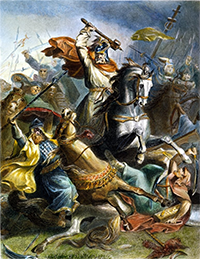
In 679, Pepin II became the Austrasian Mayor of the Palace and set his sights on consolidation. Eight years later, he was the leader of all the Franks. He died in 714, without a legitimate son. His surviving grandsons claimed power, but so did his son, Charles. The three went to war against one another, and Charles emerged the victor. He was such a talented fighter that he earned the name Charles Martel ("Charles the Hammer"). Martel (left) solidified his rule and then turned the Frankish armies northward, to stop raids there by Bavarians, Frisians, Saxons, and other Germanic tribes. The Franks were largely successful in this. 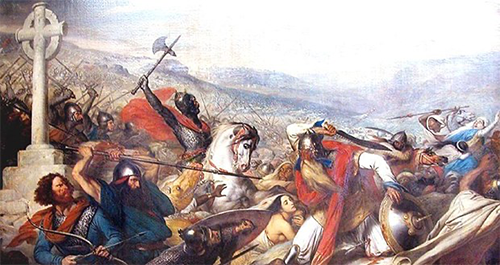
Turning south, Martel led his forces into a large concentration of Muslim forces, who had stormed through North Africa, crossed the Mediterranean, and then seized most of what is now Spain. In 732, the two titanic armies clashed at Tours. After a fierce struggle, the Franks defeated the Arabs, who retreated across the Pyrenees, never to return. Many historians consider this battle to be one of the major turning points in history. Martel had a legitimate son, Pepin III (also known as Pepin the Short), so the succession of power was secure. Pepin was still "only" the Mayor of the Palace but was, in effect, the true power behind the king, Childeric III. In 751, Pepin dispensed with the fiction and named himself King of the Franks. He had the support of the pope to do this. 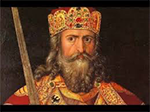
Pepin the Short died in 768, and his son Charles succeeded him, along with his brother Carloman. This was the famous Charlemagne ("Charles the Great"), who ruled alone from 771, when his brother died. Charlemagne (left) earned his famous name by conquering most of Italy and most of Germany, creating an empire the likes of which hadn't been seen in Europe in a few centuries. Pepin and his descendants came to be known as the Carolingian Dynasty, named for Charles Martel. Pepin had campaigned against the Lombards in the 750s. Charlemagne did so as well, in 773, finally subduing that people and bringing them into the Frankish fold. 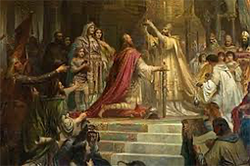
Turning north, Charlemagne targeted the Bavarians and the Saxons. He had little trouble with the former; to conquer the latter took three decades. It was not until 804 that the Saxons submitted to Frankish rule. By that time, Charlemagne had been emperor for four years. On Christmas Day, in a ceremony at St. Peter's in Rome, Pope Leo III placed a crown on Charlemagne's head and declared him thus: "Charles, most serene Augustus, crowned by God, great and pacific emperor, governing the Roman empire." The Byzantines were still thinking of themselves as the carriers of the Roman flame at this time, and this pronouncement didn't sit well with the Byzantine emperor, who at the time was Irene of Athens, who had succeeded her husband, Leo IV, on the throne. (The pope considered her invalid to rule because she was a woman.) One of Charlemagne's few failures was an expedition against Muslims armies in what is now Spain in 778. Frankish armies seized the town of Pamplona but could not take Saragossa and so decided to abandon the expedition. 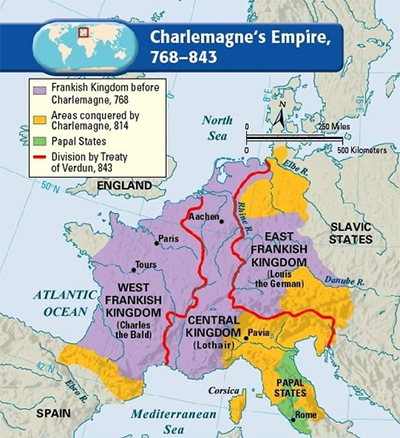
At its height, the land controlled by Charlemagne included all or parts of what is now Austria, Belgium, France, Germany, Italy, the Netherlands, Spain, and Switzerland. Charlemagne accepted the title of Emperor of the Romans and established his capital at Aachen, far to the north of Rome. The pope journeyed to Aachen in 805 to consecrate a new chapel that Charlemagne had built there. The Aachen chapel became a place of learning. Alcuin, the famous scholar from Brittania, had come in 780 to found a school at Aachen. When Charlemagne died, in 814, he had one surviving son, Louis, who inherited the entire kingdom. He became known as Louis the Pious because of his preference for religion and study and not military prowess. Charlemagne had angered Saxon leaders by his long campaign to subdue them. When he died, they took the opportunity to invade. Louis did his best to defend the realm but found it easier to pay the invaders not to come back. When Louis died in 840, his three sons divided the Frankish Empire between them. A civil war ensued and, three years later, ended with the Treaty of Verdun and the division of Frankish territory into three kingdoms:
First page > Conflicts with Rome > Page 1, 2 |
|
Social Studies for Kids
copyright 2002–2026
David White




